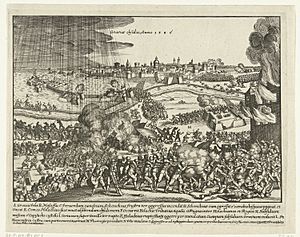Siege of Grave (1586) facts for kids
Quick facts for kids Siege of Grave (1586) |
|||||||
|---|---|---|---|---|---|---|---|
| Part of the Eighty Years' War and the Anglo-Spanish War (1585–1604) | |||||||
 The Siege of Grave in 1586 by Don Alejandro Farnesio – engraving by Michelangelo Cerquozzi |
|||||||
|
|||||||
| Belligerents | |||||||
| Commanders and leaders | |||||||
The Siege of Grave was an important event that happened in 1586. It is also known as the Capture of Grave of 1586. This battle took place in a town called Grave in the Low Countries, which is now part of the Netherlands.
The fight was between the Spanish army and forces from the Dutch-States and England. The Spanish army was led by Alexander Farnese, who was a powerful general. The Dutch and English forces were led by Baron Peter van Hemart. This siege was part of two bigger wars: the Eighty Years' War and the Anglo-Spanish War (1585–1604).
Contents
What Was the Siege of Grave?
A siege happens when an army surrounds a town or city to try and take control of it. They block supplies from getting in and out. The goal is to force the people inside to surrender.
Why Was Grave Important?
Grave was a very important town because of its location. Controlling Grave meant controlling key routes and rivers in the area. This made it a valuable prize for both sides during the wars.
Key Events of the Siege
The siege of Grave started in February 1586. Count Peter Ernst of Mansfeld, following orders from Alexander Farnese, began to surround the town.
The Spanish army kept Grave surrounded for about three months. During this time, the English and Dutch forces tried to send help to the town, but they were not successful.
The Surrender of Grave
Because no help arrived, the people defending Grave had to give up. On June 7, 1586, Grave surrendered to the Spanish army. This was a big win for Spain.
What This Meant for the War
Taking Grave was a major success for the Spanish. It showed how strong Alexander Farnese's army was. For the English and Dutch, it was a difficult loss.
The English commander, Sir Robert Dudley, Earl of Leicester, was not able to help Grave. This made many Dutch leaders unhappy with him. It also caused disagreements between the States-General of the Netherlands (the Dutch government) and the Earl of Leicester.
After the Siege
A few days after taking Grave, the Spanish army moved on. They then began to surround another town called Venlo. This town was defended by Dutch and English soldiers. On June 28, 1586, the defenders of Venlo also had to surrender to the Spanish.
See also
- Battle of Empel
- Battle of Boksum
- Siege of Venlo (1586)
- Destruction of Neuss
- Treaty of Nonsuch

